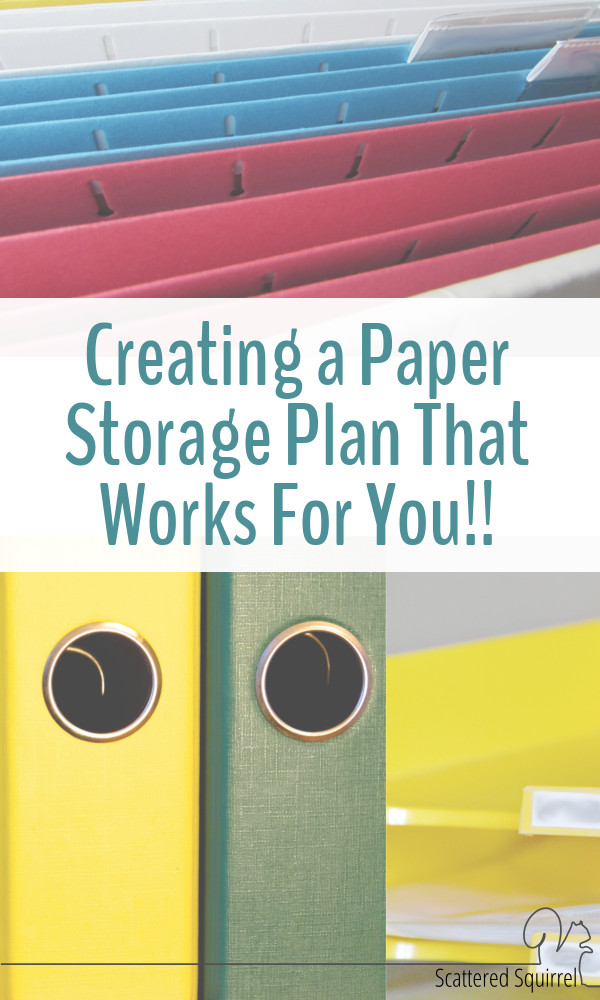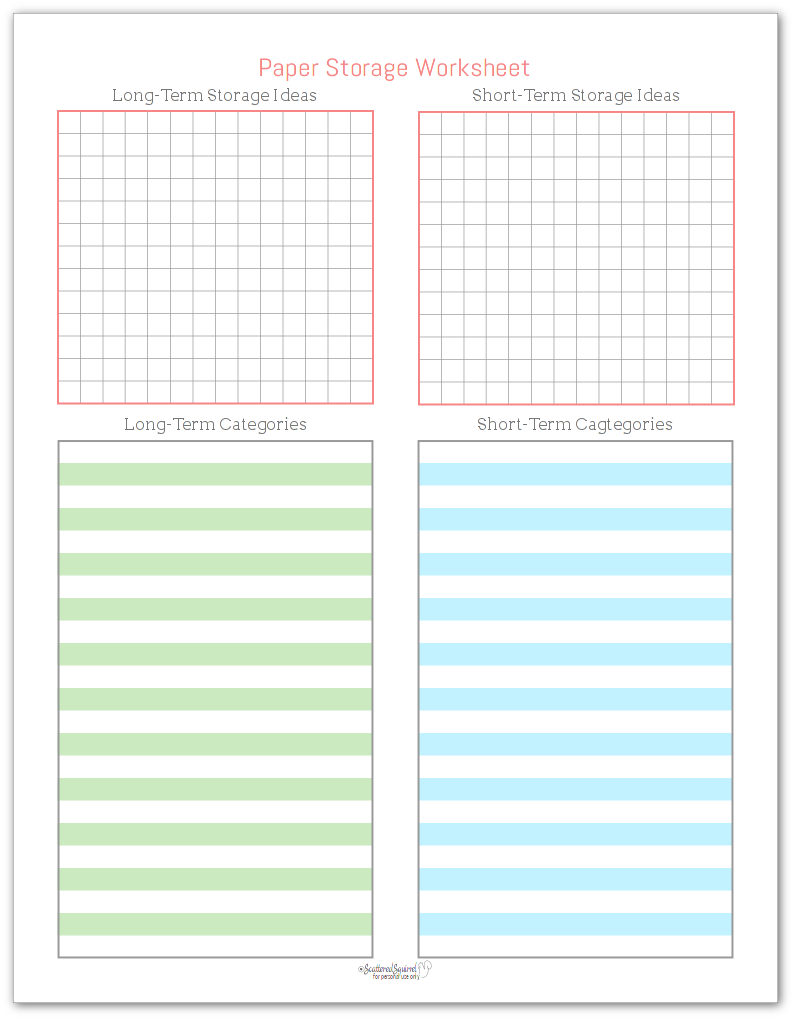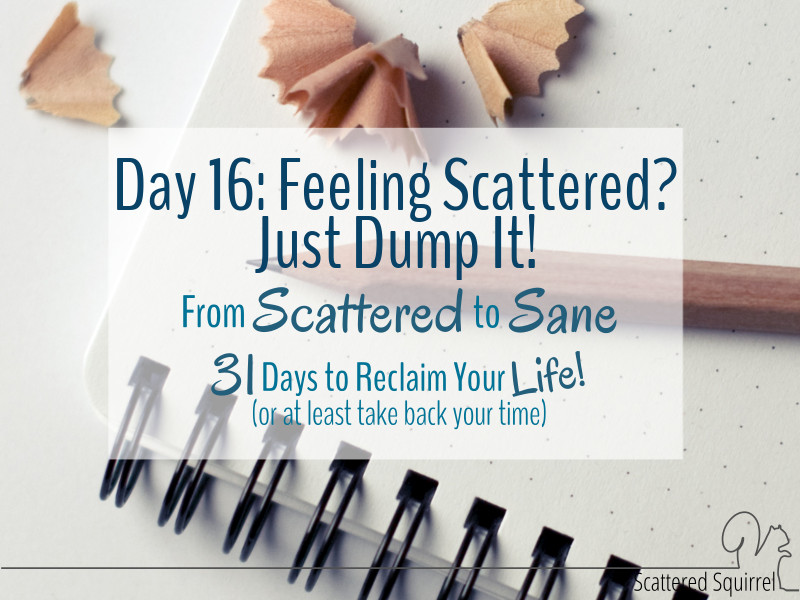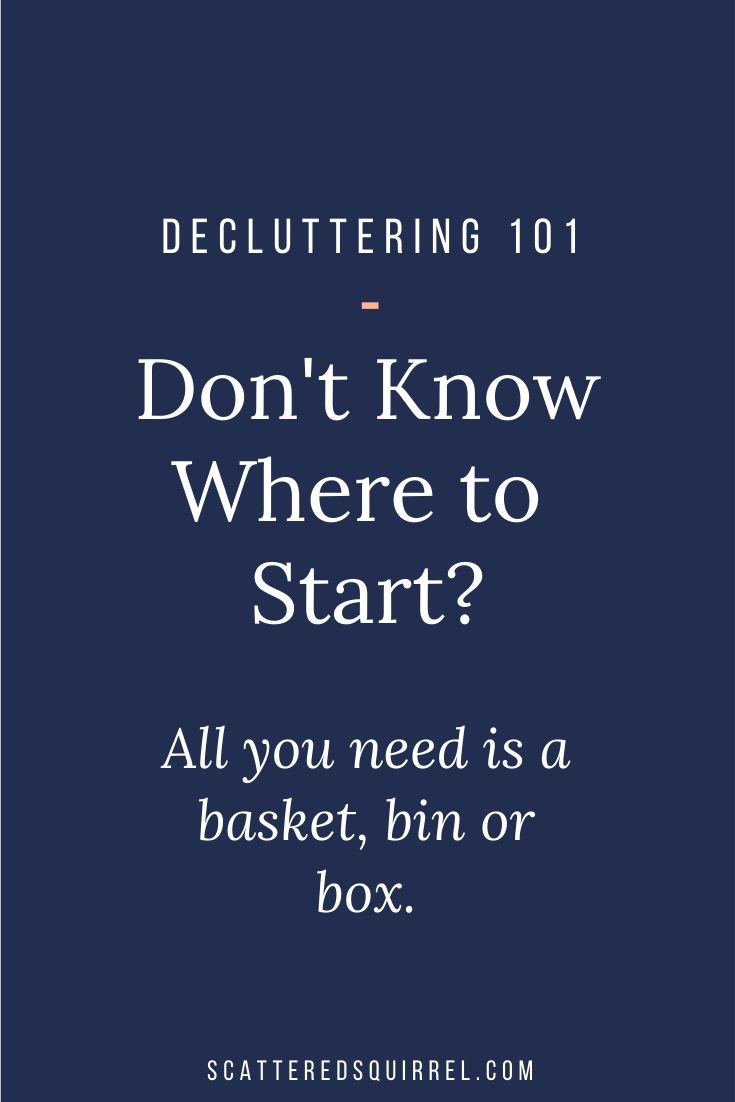Creating a Paper Storage Plan That Works For You
So, here we are at step two of the Cure the Paper Organization Blues, and already I’m changing things up. We already set up a plan for handling incoming papers and gathered up all the papers from around the house that need organizing. But before we can dive into the task of sorting and purging, we need a plan for where we’re going to put all that paper when we’re done. I don’t know about you, but the less I have to handle the papers the easier this job is going to be. So today we’re going to talk about how to make a plan for our paper storage.
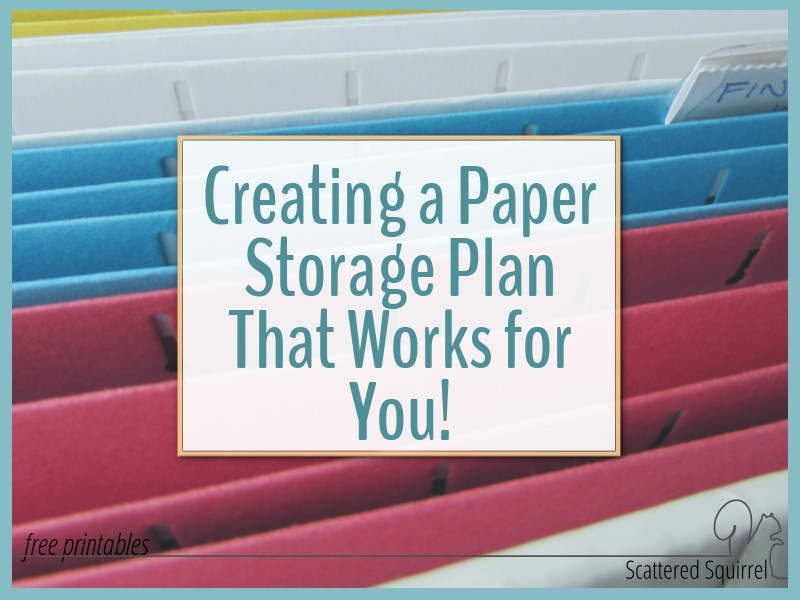
Creating a Plan for Your Paper Storage
Over the years I’ve looked into many ideas for how to store papers and I’ve come to the conclusion that there are really only three categories, or levels, of paper storage that need to be considered. We’ve already tackled the first level when we set up our system for handling incoming papers. This level is very temporary. It is just a holding place for papers until we act on them and/or file them away for later. The next levels of storage are where we put the papers once we’re done with them. These are the two levels we’re going to talk about today – our short and long-term paper storage.
It is always a good idea to check with your provincial/territorial/state and federal governments to be sure you’re keeping things for the right amount of time. I found the following two articles with general guidelines on what to keep and how long to keep it for but make sure you double check that info.
My advice – if you’re not sure, keep it! It may go against normal organizing advice, but in the case of papers and documents, I feel it’s better to err on the side of caution.
Long-Term Storage
My rule of thumb is that if you have to keep it for more than a year, iCreating a Paper Storage Plan That Works For Yout belongs in your long-term paper storage. Things like:
- tax returns
- medical records
- birth, marriage, citizenship, death, and other certificates
- legal documents
- loan documents
- deeds and other proof of ownership papers
- life insurance documents
- wills
How much you need to store long term, depends on your own individual circumstances.
Once you figure out the what you can determine the where. Most of us won’t need to access these papers on a regular basis, so we can easily store them somewhere that is out of the way, but there are many ways to store these types of papers.
- dedicate one drawer in your file cabinet for long-term storage
- plastic bin/file box that you can fit with hanging folders to keep everything neat
- plastic bin with large envelopes to hold different categories of papers
- bankers box
- accordion file boxes
- accordion file folders – you can use a few to separate categories
I use an accordion file box to store all our important and long term papers. It works really well for our family and our needs. What I really like about this system is that it is flexible and if we need more room I can add a second one if I need to. It’s also portable, so in the case of an emergency (I live in an earthquake zone) I can just grab and go and our important files are with us.
Short Term Storage
This layer of storage is for all those papers you might need to hold onto for a while. My rule of thumb for this layer is anything that I need to keep for more than a month goes here. Sometimes paper I store here move over to my long-term paper storage, like:
- payslips
- receipts for taxes
- medical documents
Most of the papers I would consider for short-term storage would be things like:
- utility bills (if you like to keep them)
- bank statements
- credit card statements
- loan statements
- insurance (car, home, health)
- school report cards
- medical documents
Short-term paper storage is more likely to be used and accessed more often than long-term. Whether it is adding papers to it, taking papers out to deal with them, or double check information, there is a better chance that these kind of papers are going to get used a little more frequently. You want to keep that in mind when choosing a storage option. Some great options for short-term storage are:
- file cabinet with hanging file folders
- open top file box
- basket to hold files
- binders (many people are using binders more and more to store their papers)
- stacking paper trays or scrapbook shelves (pilers this might be an option for you)
- magazine files with vertical file holders
- wall mount magazine holders with file folders
The options are pretty limitless when it comes to storing your papers. As long as you can find them when you need them, any solution you choose will be fine.
Tips for Setting Up Paper Storage Solutions That Work For You
I say it all the time – your systems need to work for you, not the other way around, and paper storage systems are no different. You need to create a system that you can easily maintain and access without too much work on your part. Setting it up might take work, but after that, it should be fairly easy to keep up with it. I always approach creating systems by asking myself a few questions:
- Are you filer or a piler? We touched on this last post. How you naturally deal with paper will play a big role in how you create your storage systems. For me, the only real filing I have to do is for my long-term storage. It works for me because I really only have to touch those files once or twice a year.
- How many categories/sections will you need? There are a ton of articles and videos out there to help you figure out what categories and subcategories you need for storing your papers (if any). I keep mine really simple, but other people need more structure. My favourite resource for paper organization inspiration is Alejandra’s Home Office and Paper Management videos.
- What materials will you need? Create a list of what you’ll need. Shop your house for options you might already have at home to save some money. If you’re not sure about whether or not your system will work as you think it will, head to the dollar stores or thrift stores to see if you can find something similar to what you need before you invest in something new. Some of the supplies you might need could include:
- file cabinet, box, or basket
- folders, hanging and tabbed
- labels
- larger envelopes
- binder clips or paper clips
- accordion files
- binders
- paper trays
- paper drawers/shelves
Special Note for Pilers
The world of paper storage and organization can sometimes feel like we need to force ourselves to adapt, which often leads to systems that stop working or hours spent getting caught up on our filing. There are a few tricks I’ve adopted over the years to help me work with my piling nature and I wanted to share some of them with you.
- Large envelopes work wonders for long term storage. You can use one for each category and slip the documents inside. Then you can pop the envelopes into a bin and it’s easy to find them when you need them.
- Binder clips and folders work really well together. I used to keep a stack of folders on my desk to help organize my papers. They were kind of like make-shift paper trays. I used binder clips to keep the papers clipped to the folder so they didn’t fall out when I moved them.
- Binder clips with labels help keep piles neat and make it super easy to find what you’re looking for. You don’t have to buy fancy binder clips, just use some masking or washi tape around one of the prongs and a permanent marker to write on them.
- Paper sorters/shelves can be labeled like files and used to keep your papers organized without sticking them in a file.
You might need to get a little creative and think outside the box, but you can create a system that will work for you.
Write Your Plan on Paper
Take a few minutes to jot down your ideas for your storage solutions. I like to make two lists, one for short-term one for long-term. I start by listing my ideas for how to store them. Then under that, I create a list of categories or subjects I plan to organize my papers into. That way, when it comes time to sort, I only have to sort once.
Handy Printable to Help You Out
It’s important to get our ideas out of our head and onto paper so we can fully map out our paper storage plan. To help I created a printable to help us organize our papers before we start sorting. We can create our plans for short and long-term storage and help make the sorting process easier.
As you can see I kept it super simple like always. One column for each with a space for storage ideas and a space for categories you plan to organize your papers by. As always, to snag a copy of the printable for yourself, simply click the picture and you’ll be taken to the PDF file.
No matter how hard we work at going paperless – even if we scan all our long-term documents into our computers, we still a place to store the originals. With a little thought and planning, we can create a paper storage system that will work well for us for years to come.
Now it’s your turn? Do you have and tips for suggestions to make paper storage easier? Do you have a system that is working well for you? Drop a line in the comments below and let us know.
